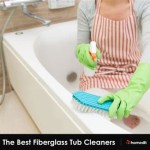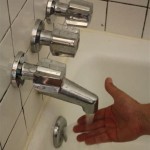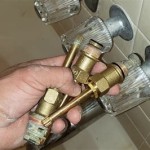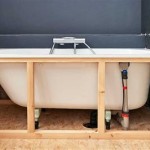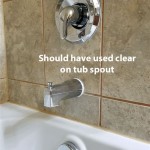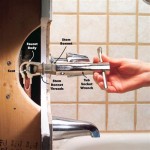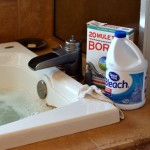Best Cleaners for Bathtub Mold Removal
Mold growth in bathtubs is a common household problem, thriving in the humid, dark environment created by frequent water exposure and poor ventilation. Not only is mold unsightly, but it can also pose health risks, especially to individuals with allergies, asthma, or weakened immune systems. Therefore, maintaining a mold-free bathtub is crucial for hygiene and overall well-being. Selecting the appropriate cleaner is the first step in effectively removing and preventing mold from recurring.
Several factors contribute to mold growth in bathtubs. These include inadequate ventilation, allowing moisture to linger after bathing or showering; the presence of organic materials, such as soap scum and body oils, which serve as food sources for mold; and the porous nature of some bathtub surfaces, which can trap moisture and provide a breeding ground for mold spores. Understanding these factors is essential for implementing preventative measures alongside regular cleaning practices.
The effectiveness of a mold cleaner depends on several criteria. Its ability to kill mold spores and remove visible mold stains is paramount. The cleaner should also be easy to apply and use, minimizing the effort required for mold removal. Furthermore, the safety of the cleaner is a significant consideration, particularly regarding its potential to irritate skin, eyes, or respiratory systems. Finally, the residual effect of the cleaner, meaning its ability to prevent mold from returning, is a key factor in maintaining a mold-free bathtub over time.
Identifying Mold on Bathtubs
Correctly identifying mold is important to ensure that the most appropriate cleaning method is selected. Mold typically appears as black, green, brown, or white spots or patches on bathtub surfaces. These spots may be fuzzy or slimy in texture. Mold can often be found in areas where moisture tends to accumulate, such as around the drain, along the caulk lines, and in corners. It is vital to distinguish mold from mildew, which is another type of fungus that often grows in bathrooms. Mildew typically appears as a flat, gray or white powdery substance, and it is generally easier to remove than mold. If the discoloration is deep, penetrates the surface, or has a fuzzy appearance, it is more likely to be mold.
Distinguishing mold from stains and build-up is also crucial. Stains, such as hard water stains or mineral deposits, often have a different texture and appearance than mold. They are usually smoother and harder to remove with a simple wipe. Similarly, soap scum, which is a combination of soap residue, body oils, and minerals, can accumulate on bathtub surfaces and create a sticky or greasy layer. While soap scum can contribute to mold growth by providing a food source, it is not mold itself. Proper identification allows for targeted cleaning, ensuring efficiency and preventing unnecessary use of harsh chemicals.
It is important to note that if the mold infestation is extensive, covering large areas or penetrating deeply into the bathtub's structure, professional mold remediation services may be required. Attempting to remove severe mold infestations without proper training and equipment can be hazardous and may not completely eliminate the problem.
Effective Mold Cleaning Solutions
Numerous cleaning solutions can be employed to tackle bathtub mold, each with its advantages and disadvantages. Chlorine bleach is a widely used and effective option for killing mold spores and removing stains. However, it is a harsh chemical that can irritate skin, eyes, and respiratory systems, and it can also damage certain bathtub surfaces. Vinegar, particularly white distilled vinegar, is a milder alternative that is effective against many types of mold. It is also a more environmentally friendly option. Hydrogen peroxide is another mold-killing agent that is less harsh than bleach and can be used on a variety of surfaces. Baking soda, often mixed with water to form a paste, is a gentle abrasive cleaner that can help remove mold stains.
Commercial mold and mildew cleaners are specifically formulated to target mold growth and are available in various forms, such as sprays, gels, and foams. These cleaners often contain a combination of ingredients designed to kill mold spores, remove stains, and prevent future growth. It is crucial to carefully read and follow the manufacturer's instructions when using commercial mold cleaners, paying attention to safety precautions and recommended application methods.
The effectiveness of a particular cleaning solution can depend on the type of mold, the severity of the infestation, and the bathtub material. For instance, porous materials like grout may require more aggressive cleaning methods than non-porous surfaces like acrylic. It is often advisable to test a small, inconspicuous area of the bathtub before applying any cleaning solution to the entire surface, to ensure that it does not cause discoloration or damage.
Step-by-Step Guide to Cleaning Bathtub Mold
Before commencing the mold removal process, it is vital to gather the necessary supplies. These typically include the selected cleaning solution (e.g., bleach, vinegar, commercial mold cleaner), protective gear (e.g., gloves, mask, eye protection), cleaning tools (e.g., scrub brush, sponge, spray bottle), and ventilation aids (e.g., opening windows, using a fan). Wearing protective gear is essential to prevent skin irritation, respiratory problems, and eye damage from exposure to mold spores and cleaning chemicals.
The first step in cleaning bathtub mold is to prepare the area. This involves removing any loose items from the bathtub, such as bath mats, toys, and toiletries. Thoroughly rinse the bathtub surface with water to remove any loose debris and soap scum. Next, apply the chosen cleaning solution to the affected areas, following the manufacturer's instructions or the guidelines for the specific solution being used. Allow the solution to sit on the mold for the recommended amount of time, typically 10-15 minutes, to allow it to penetrate and kill the mold spores.
After the dwell time, use a scrub brush or sponge to vigorously scrub the mold-affected areas. Pay close attention to areas with heavy mold growth, such as corners and grout lines. Rinse the bathtub thoroughly with water to remove all traces of the cleaning solution and dislodged mold spores. If necessary, repeat the process for stubborn mold stains. Once the cleaning is complete, thoroughly dry the bathtub surface with a clean towel. This helps to prevent moisture from lingering and promoting future mold growth. Finally, ensure adequate ventilation in the bathroom to allow the area to dry completely.
For persistent mold problems, consider using a sealant after cleaning. Applying a mold-resistant sealant to grout lines and caulk can help prevent moisture from penetrating and creating a favorable environment for mold growth. Regularly inspecting and cleaning the bathtub will help to identify and address any potential mold problems early on.
Safety Precautions and Considerations
When using cleaning solutions, particularly those containing harsh chemicals like bleach, it is crucial to prioritize safety. Always wear gloves to protect the skin from irritation and potential chemical burns. A mask or respirator should be worn to prevent inhaling mold spores and chemical fumes. Eye protection, such as goggles, is essential to prevent splashes of cleaning solution from entering the eyes.
Adequate ventilation is paramount when cleaning mold. Open windows and doors to allow fresh air to circulate, or use a fan to improve airflow. This helps to dissipate chemical fumes and reduce the risk of respiratory irritation. Avoid mixing different cleaning solutions, especially bleach with ammonia, as this can create toxic and potentially deadly gases.
Individuals with allergies, asthma, or respiratory sensitivities should take extra precautions when cleaning mold. Consider having someone else perform the cleaning task if possible. If that is not feasible, wear a high-filtration respirator mask and take frequent breaks to get fresh air. Consult a healthcare professional if you experience any adverse reactions, such as difficulty breathing, coughing, or skin irritation.
It is also vital to properly dispose of any cleaning supplies used in the mold removal process. Place used sponges, brushes, and cloths in a sealed plastic bag before discarding them to prevent the spread of mold spores. Wash protective clothing, such as gloves and masks, thoroughly after use. Store cleaning solutions in a safe place, out of reach of children and pets.
Preventing Future Mold Growth
Preventing mold growth in the bathtub is often more effective than repeatedly removing it. Improving ventilation is one of the most important steps. Ensure that the bathroom is adequately ventilated by opening windows or using a fan during and after bathing or showering. This helps to remove moisture from the air and prevent it from condensing on surfaces.
Regular cleaning is also essential. Wipe down the bathtub surface after each use to remove excess water and soap scum. Clean the bathtub thoroughly at least once a week with a mild detergent or mold-inhibiting cleaner. Pay particular attention to areas prone to mold growth, such as corners, grout lines, and around the drain.
Addressing moisture sources is crucial. Repair any leaky faucets or showerheads promptly to prevent water from accumulating in the bathtub. Consider using a squeegee to remove water from the walls and shower door after each use. Avoid leaving wet towels or bath mats in the bathroom, as they can contribute to moisture buildup.
Choosing mold-resistant materials can also help. When remodeling or renovating a bathroom, consider using mold-resistant grout, caulk, and paint. These materials are designed to inhibit mold growth and make cleaning easier. Regularly inspecting the bathtub and bathroom for signs of mold or moisture problems will allow you to address them early on before they become more severe.

The Mold And Mildew Remover You Need For Cleaning

10 Best Shower Cleaners Of 2024 Reviewed
Best Bathtub Cleaners Of 2024

Black Mold In The Shower How To Clean It Kitchen With Matt

7 Best Tile Grout Cleaners Of 2024 Tested By Experts

Oxiclean Plus Bleach No Drip Foam Mold Mildew Bathroom Stain Remover 30 Oz Com

Best Shower Cleaners Of 2024 Expert Picked U S News

Clorox Plus Tilex Mold Mildew Remover

How To Clean Mold From Your Bathtub Using Toilet Paper Mental Floss
Black Mold In The Shower How To Clean It Kitchen With Matt

